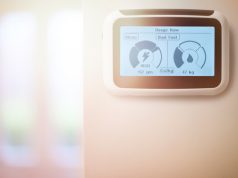Electrical heating seems at first thought like a straightforward choice.
It’s cleaner, technologically advanced and greener than gas, but there are still several things to consider before you go ahead with installation.
Firstly, there’s the question of which heating is suitable for the space you wish to warm.
The most common types of electric heating are night storage heaters, convection heaters and electric radiators.
Also there’s the question of cost.
According to consumer magazine Which?: ‘As electricity is more expensive than gas, storage heaters are only really cost-effective if you don’t have mains gas.’
Types of primary electrical heating
Electric radiators
Electric radiators are becoming a more popular choice for those who are updating their homes’ heating systems, as they are cost effective and have all the advantages of convection heating.
They operate in a similar way that standard radiators do, using multiple heating elements within the radiator that are heated quickly by electric and provide an even heat distribution.
Pros
- Easy and cheaper to install.
- They are perfect for radiating and convecting heat at a comfortable temperature.
- Low maintenance.
- You don’t need the pipework of a boiler.
- You can have temperature controlled heating both day and night.
- Space saving.
- No heat leakage.
Storage Heaters
This type of heater normally uses cheap rate electricity (off peak) to store the heat needed by the property over the day.
Pros:
- Can be a cheaper way to heat the home If you’re on a time-of-use tariff, such as Economy 7 or Economy 10, which will give lower off-peak electricity rates.
- They keep the home warm during the night and early morning.
- Where mainline gas isn’t available, night storage heaters provide the heating.
- Installation is easier and cheaper than new central heating systems.
- Low or no maintenance required.
- No pipework or boiler required.
Cons:
- Heat is lost while charging overnight.
- The night time electric tariff is often only as good as a normal tariff and does not necessarily result in cheaper heating costs.
- Heat is released during the day regardless of whether it is needed or not.
- Controls can be complicated to use and therefore if mishandled they could lose heat at the wrong times of the day and night.
- They are heavy and bulky and usually take up more floor space than radiators used in other heating systems.
- Dust can be released from the heater when the fan is used to increase the heat transfer.
- Also storage heaters are not ideal for asthma sufferers due to the fact they burn the air.
High heat retention storage heater
This type of heater operates in the same way as a normal storage heater, except that it has been considerably improved to reduce the heat losses from the product and has more significantly advanced controls.
Pros: This type of heater is up to 27% more efficient than standard storage units, receiving special consideration in Standard Assessment Procedure (SAP).
Cons: Could also be expensive.
Convection heaters
Convection heat warms a room from the top down; it uses the natural movement of air which rises when warm, drops as it cools and so on. The main advantages of convection heaters are that you can turn them on and off independently from each other, allowing you to heat the spaces you need, when you need to. They are also less bulky than night storage heaters.
Pros:
- Convection heaters warm up a room evenly. That’s because the warm air they create rises and falls uniformly across an enclosed space.
- Convection panel heaters can be mounted higher up on any open wall space in any size of room.
- The temperature of each room can be controlled individually.
- In most cases, convection heaters are silent, unless they are the fan-equipped heaters most commonly used in bathrooms.
- Convection heaters save about 10 per cent more in energy costs when compared to electric baseboard heaters.
Cons:
- Because convection heaters don’t contain air filters and do move the air around in a room, they can create a lot of dust disturbances. This can be a problem for people with dust allergies.
- Both storage heaters and convection heaters mainly convect heat up to the ceiling.
- Convection heaters can cost more to run as they are pretty heavy on electric due to the technology inside the heater.
Here are some things to think about before you opt for electrical heating
- Where will you position the heaters? You’ll want them to heat the room efficiently so they shouldn’t be blocked by furniture or clothing.
- What are your living habits? Will storage heaters in each room be a waste of energy if you only use one or two rooms in the house?
- How much money do you want to spend? Work out your budget and stick to it. You can always install more heaters at a later date.














